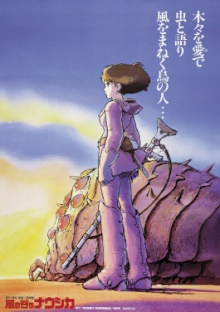My wife has been raving about this one film since forever and it’s only just now that I’ve gotten around to watching it. Though this predates Studio Ghibli, it’s commonly considered their first film as its success was what made the studio possible. It was also based on a manga written and illustrated by Hayao Miyazaki himself so it’s a hundred percent his work. I found this to be far different from the later Ghibli films in so many ways: it’s explicitly violent with the heroine herself killing multiple people on screen, it depicts warfare and death on a grand scale and it’s straight out science-fiction. In fact, I’m pretty sure that Vesper was directly inspired by its imagery. As such, yeah, I’m pretty sure this is my favorite of the Ghibli films as well.
A world war has destroyed industrial civilization as we recognize it and what remains of humanity have retreated into isolated enclaves. They are fearful of the Forest of Decay, full of strange mutated organisms with the air itself being toxic to humans. The forest is protected by giant insects and seems to be spreading every year. Nausicaä is a princess in the Valley of the Wind who enjoys flying on her glider and seems to have a rapport with the insects. One night, an aircraft from the more powerful kingdom of Tolmekia crashes into their valley. It is carrying a Giant Warrior, an ancient weapon from before the apocalypse, stolen from the kingdom of Pejite. This causes an army from Tolmekia to arrive in the valley to recover the weapon, killing Nausicaä’s father in the process. She urges her people to submit to the conquest after killing several warriors herself in a fit of rage. While being transported back to Tolmekia as a hostage, the airships are attacked by a Pejite interceptor. Nausicaä, her men and the Pejite pilot Asbel then crash and find themselves inside the Forest of Decay.
After getting used to Studio Ghibli’s style, I can’t emphasize enough how much of a shock it is to see that not only does Nausicaä carry a rifle around, but she knows how to use it and actually does kill people. The death and devastation both shown and implied are massive in scale and some of the actions taken by the combatants are essentially genocidal war crimes. This film really doesn’t hold back. Of course the theme here is ultimately still about bringing about peace and Nausicaä is a Messiah-like figure who convinces all parties to lay down their arms through her own personal sacrifice. The readiness to show real violence and loss makes the film very impactful as you can feel just how high the stakes are. On the other hand, it makes it quite difficult to believe that Nausicaä’s pacifism could really work. I mean, they’ve already killed thousands, are they really going to balk at shooting just one more girl? Still I have to commend how seriously Miyazaki takes this story, that it is just a fairy tale for children. One complaint is that Nausicaä is too hypercompetent as a heroine which strains your credulity even more. She can dodge bullets on her glider, is an amazing swordswoman, is a pioneering biologist and so on. A little restraint would be preferable here.
The art quality here is noticeably lower compared to the more refined look of the actual Studio Ghibli releases but it makes for it with inventive visual designs. Between the giant, mutated insects and otherworldly plants, the pastoral look of the Valley of the Wind, and the war machines of the Tolmekians, this really does look like science-fiction. It makes a difference that Miyazaki had made a manga before starting work on this adaptation. I note that the original story has an even stronger science-fiction identity as Nausicaä discovers that the Forest of Decay itself is an artificially engineered ecosystem created by humanity before its downfall. Given that Miyazaki’s later work encompasses a relatively narrow range of characters and themes, it’s fascinating to peek behind the veil to see that his imagination stretches farther than what is shown in his films.
The upshot is that this feels significantly different from any of the other Studio Ghibli works. It’s more violent, it has less of a Japanese influence and seems in fact inspired primarily by American science-fiction, and it definitely isn’t a watered down children’s movie. To me, it’s fantastic and it’s such a shame that Miyazaki didn’t make more films that more oriented towards adults.

2 thoughts on “Nausicaä of the Valley of the Wind (1984)”